Healthy Building Network (HBN) recently published a report that, unsurprisingly, gets a lot of facts wrong and presents an entirely one-sided view to promote its well established anti-PVC bias.
In its latest post, HBN tells its supporters that plastic construction products are uniquely bad for the environment while ignoring the fact that PVC and many other plastic building products are significantly more sustainable than many alternatives. HBN claims that “any comprehensive climate change plan must curb the production of plastics” used in construction. But the authors omit, for instance, lifecycle analyses showing that PVC pipes have significantly lower embodied carbon and greenhouse gas emissions than metal alternatives like iron and copper.
Ultimately, HBN’s unhinged broadside against plastic fails to ask the more important question: compared to what? HBN attacks latex paint because it’s “mostly plastic”; do they want to see a return to lead-based paint from the 1970s? They attack polystyrene insulation because it’s a kind of plastic; would they like to give up the enormous gains in energy efficiency that foam insulation has achieved? HBN criticizes the use of synthetic turf which minimizes the need for water and fertilizer and reduces carbon emissions from lawn maintenance equipment; would HBN prefer the alternative?
The fact is, avoiding plastics in construction is likely to make buildings less sustainable and more expensive. The only way to meet HBN’s unrealistic objectives is to build less, which will only lead to fewer affordable housing options for decades to come.
Like most of HBN’s pie-in-the-sky reports, this one misleads, obfuscates, and gives readers a completely backwards impression of the role of plastics in making construction greener.
We’ve come to expect this kind of fear-mongering from HBN. That’s why Vinyl Verified exists -- to ensure these baseless attacks against PVC don’t go unchallenged in the public discourse.


